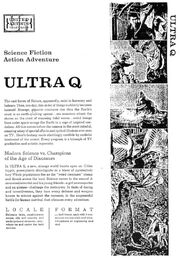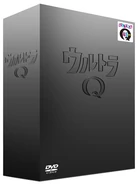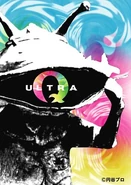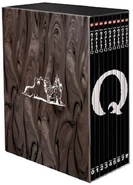| ||
| Why is this bad? |
Ultra Q is a tokusatsu SF/kaiju series made in the tradition of Toho's many tokusatsu sci-fi/horror films.
Produced in black and white by Tokyo Broadcasting System/Tsuburaya Productions, this is actually the first of the long-running Ultra Series, and was broadcast on Tokyo Broadcasting System from January 2 to July 3, 1966 (the final episode was preempted until December 14, 1967), with a total of 28 episodes. This series was followed a week later by the more popular Ultraman (Urutoraman, 1966-1967), the second Ultra Series.
Ultra Q can be described as a half-hour Toho kaiju film. Although series creator Eiji Tsuburaya intended this series to be more like The Twilight Zone and focus less on the monsters, TBS convinced Eiji to add more monsters onto the show, as Godzilla (Gojira) and Gamera were very popular at the time (the first "Kaiju Boom" was already born).[1] This series predates The X-Files with continuing characters who investigate strange supernatural phenomena, including giant monsters, aliens, ghosts, and other assorted calamities. Perhaps the closest parallel in American TV is The Outer Limits, which in its original form generally featured a monster each week.
Regarding the monsters, some of them were modified versions of Toho movie monsters (since Eiji owned the costumes). They include Godzilla (as "Gomess " in Episode 1, "Defeat Gomess!"), King Kong (as "Goro" in Episode 2, "Goro and Goro"), Manda (as "Mystic Dragon" in Episode 6, "Fly, Turtle!"), Baragon (as "Pagos" in Episode 18, "The Rainbow Egg"), Maguma (as Todola in Episode 27, "Flight 206 Vanishes"), and the Giant Octopus from King Kong vs Godzilla (1962) (as "Sudar" in Episode 23, "Rage in the South Seas").
The original planned title of this project was UNBALANCE, and was subsequently renamed Ultra Q (inspired by "Oba-Q", the nickname of the title character of the then-popular anime series Obake no Q-Taro, and "Ultra C", a popular term used for women's gymnastics during the 1964 Summer Olympics, where a Russian gymnast created an extremely difficult maneuver called the "Ultra C"). The series was produced beforehand all through 1965 (it went in production as far back as 1964) and was broadcast at the beginning of the next year. At the time, this was the most expensive TV series in Japan.[2]
In 2012, the series was released in DVD & Blu-Ray in Color, to commemorate the series' 47th anniversary. On May 11, 2013 Shout! Factory announced they will release the DVD set in the US on August 13, 2012.
Characters
- Jun Manjome : Aviator at Hoshikawa Air Service and amateur SF writer.
- Yuriko Edogawa : Reporter for the Daily News.
- Ippei Togawa : Jun's aviation partner at Hoshikawa.
- Professor Ichinotani : World renowned scientist, and occasional assistance to Jun, Yuriko and Ippei in times of crisis.
- News Desk Editor, Seki : Yuriko's boss and editor at the Daily News.
Monsters
- List of Ultra Q monsters

The monster Gomess from episode 1. The monster was brought to life with a modified Godzilla suit from the films Mothra vs Godzilla and Ghidorah the Three Headed Monster.
Because Eiji Tsuburaya had a high standing with Toho, he was able to use various suits and props from the various Toho Kaiju films for his series. The Manda prop was used for the dragon Kairyuh as well as the head being used as the front portion of a Viking ship seen in episode 12, the giant octopus prop from King Kong vs. Godzilla was used to portray Sudar, while the Maguma suit from Gorath was used to portray Todora. As well, various other suits and props were refurbished to play some of the monsters such as Godzilla for Gomess, King Kong for Goroh, Baragon for Pagos, and a small Rodan prop for the birds Largeus and Litra.
Episodes
- Defeat Gomess!
- Goro and Goroh
- The Gift From Space
- Mammoth Flower
- Peguila Is Here!
- Grow Up! Little Turtle
- S.O.S. Mount Fuji
- Terror of the Sweet Honey
- Baron Spider
- The Underground Super Express Goes West
- Balloonga
- I Saw a Bird
- Garadama
- Tokyo Ice Age
- Kanegon's Cocoon
- Garamon Strikes Back
- The 1/8 Project
- The Rainbow's Egg
- Challenge from the Year 2020
- The Undersea Humanoid Ragon
- Space Directive M774
- Metamorphosis
- Fury of the South Sea
- The Idol of Goga
- The Devil Child
- Blazing Victory
- The Disappearance of Flight 206
- Open Up!
English Dub

Page from United Artists Television's Press Kit
In 1967, Ultra Q was licensed from Tsuburaya and TBS by CBS Films, producers of The Twilight Zone. It was a package deal that not only included Ultra Q, but also Ultraman. For the task of dubbing, CBS hired Film House in Toronto, Canada, what is now DeLuxe Toronto. Tsuburaya provided translated scripts, plus English language opening and closing credits, and a custom, swirling title-card. The series itself was dubbed in its 28 episode entirety. At some point, CBS Films backed out of licencing the series, and it was picked up, along with Ultraman, by United Artists Television, producers of The Outer Limits. With dubbing of Ultra Q complete, United Artists hired Titra Studios to dub Ultraman. Ultraman was syndicated, however, Ultra Q was not, due to being in Black-and-white at a time when most television was switching to color. After Ultraman finished its run in syndication, audio and film masters, and other materials, of both series were stored in the MGM vaults. In the late 1990s and early 2000s, all materials reverted to, and were collected by Tsuburaya. [3] [4]
It is commonly believed that only one episode, specifically Episode 3, was dubbed as a pilot. This has proven not to be true as other episodes have been found either in audio prints, like Episode 3, or film or video prints. From here it can be concluded that this was not the only episode produced.
Radio Drama
Ultra Q's success earned it a weekly radio drama, starring the voices of the human cast from the Original Ultra Q with some of the old monsters, such as Kemur Man, Garamon, Gorgos, and Namegon. Other new monsters included:
- Monster Ukami
- Kijimuna
- Devil
- Angel
- Kidnapping Phantom Kemuru Hito
- Monster Princess (a female version of the 'Monster Prince' in the two Gomora episodes of Ultraman)
- Tyrant Monster Staking
- Primitive Elephant Monster Kibamanmosu
- Aquatic Monster Amarin
- Sea Monster Takoyangu
- Viper Monster Habugirasu
- Monster Alien
- Giant Bird U-PiCA
- Kagemushan
- Pegasus
- Pin Weight
- Snowman
- Mermaid
- A huge floating object.
Legacy
In the years following the show's original run, a live action film called Ultra Q The Movie: Legend of the Stars was released in 1990. As well, a radio program featuring the voices of the three original stars of the show (playing their classic characters) called The Ultra Q Club aired on Japanese radio from 2003-2004. Also in 2004, a new series called Ultra Q: Dark Fantasy was produced while another series called Neo Ultra Q began airing in early 2013.
The original concept of the show (when it was going to be called Unbalance) was ultimately used for a 13-episode horror anthology series entitled Horror Theater Unbalance that was produced by Tsuburaya Productions in 1973.
Various Ultra-Q monsters were reused or redressed for various monsters in Ultraman. The Kemur being and Ragon (now giant sized) returned, while the Garamon suit was reused as Pigmon. Other suits were altered to play other monsters such as, Peguila being altered into Chandrah, the Kemur being being altered into Alien Zetton, Pagos being altered into Neronga and later Magular and Gabora, the Semi Ningen being altered into the Alien Baltan, while Peter was altered into Gesura.
Home Media
Shout! Factory released the complete series of Ultra Q on DVD on August 13, 2013.[5]
DVD Box Sets
Total Natural Color Ultra Q Box I features episodes, & Box II features Episodes 15-28, & were released during the 45th Anniversery. Ultra Q Deluxe Edition Features All Episodes.
References
- ↑ Eiji Tsuburaya: Master of Monsters: Defending the Earth with Ultraman and Godzilla, by August Ragone, Chronicle Books (2007), ISBN 978-0-8118-6078-9
- ↑ Eiji Tsuburaya: Master of Monsters: Defending the Earth with Ultraman and Godzilla, by August Ragone, Chronicle Books (2007), ISBN 978-0-8118-6078-9
- ↑ Eiji Tsuburaya: Master of Monsters: Defending the Earth with Ultraman and Godzilla, by August Ragone, Chronicle Books (2007), ISBN 978-0-8118-6078-9
- ↑ http://www.grnrngr.com/documents/ultraq.txt
- ↑ http://www.tvshowsondvd.com/news/Urutora-Q-The-Complete-Series/18445
- The Q-Files, Complete Ultra Q Episode Guide by Jim Cirronella & Kevin Grays, Originally published in KAIJU-FAN Issue # 4 November 1996 [1] .
- Eiji Tsuburaya: Master of Monsters: Defending the Earth with Ultraman and Godzilla, by August Ragone, Chronicle Books (2007), ISBN 978-0-8118-6078-9
- Ultraman Monster Ultra Large Collection (orig.: ウルトラ怪獣大全集), Domdom (1995), ISBN 978-4-09-101411-5
- So Crazy Japanese Toys!, by Jimbo Matison, Chronicle Books (2003), ISBN 978-0-8118-3529-9
External links
- Ultra Q at the Internet Movie Database
Template:Shows and Films



